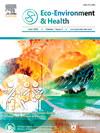使用人工智能和智能手机技术轻松进行碱度分析,不需要设备,从淡水到盐水
IF 17.6
引用次数: 0
摘要
碱度是一个重要的水质参数,具有重要的环境和工程应用。存在各种分析方法,从传统的滴定法到先进的分光光度法和电化学技术,每种方法都有特定的优点和局限性。开发简单、负担得起的碱度分析技术对于促进广泛和可靠的水质监测、赋予公民科学家权力以及克服传统监测项目的资金障碍至关重要。在这项工作中,我们开发了一种无设备、用户友好的碱度分析方法,适用于广泛的人口统计。具体来说,我们使用低成本的商业试剂来产生颜色变化,以响应各种淡水和盐水样品的碱度水平。这些图像是用智能手机拍摄的,并使用机器学习模型进行处理,以将色彩强度与碱度水平相关联。在考察了容器类型、光照条件、ML算法和样本量等因素的影响后,得出淡水和咸水的最佳模型,R2值分别为0.868±0.024和0.978±0.008,均方根误差分别为29.5±2.6和14.1±2.0。5名经验不足的用户使用该方法进行碱度分析,在性能上取得了相当的结果。此外,我们还开发了一个用户友好的网站,用户可以在没有经验的情况下上传图像以获取水样的碱度读数。这种人工智能驱动的无设备技术代表了水质监测的一个重要里程碑,偏离了发展日益先进的分析技术的趋势,并为开发跨各种水质参数和更广泛的分析应用的类似方法奠定了基础。本文章由计算机程序翻译,如有差异,请以英文原文为准。

Effortless alkalinity analysis using AI and smartphone technology, no equipment needed, from freshwater to saltwater
Alkalinity is a crucial water quality parameter with significant environmental and engineered system applications. Various analysis methods exist, from traditional titrations to advanced spectrophotometric and electrochemical techniques, each with specific benefits and limitations. Developing simple, affordable techniques for alkalinity analysis is essential to facilitate extensive and reliable water quality monitoring, empowering citizen scientists, and overcoming financial barriers in traditional monitoring programs. In this work, we developed an equipment-free, user-friendly alkalinity analysis approach accessible to a broad demographic. Specifically, we employed low-cost commercial reagents to generate color changes in response to alkalinity levels in various freshwater and saltwater samples. These images were captured with a smartphone and processed using machine learning models to correlate color intensity with alkalinity levels. After examining the effects of container type, lighting condition, ML algorithms, and sample size, we obtained the best models with R2 values of 0.868 ± 0.024 and 0.978 ± 0.008, and root-mean-square-error values of 29.5 ± 2.6 and 14.1 ± 2.0 for freshwater and saltwater, respectively. Five inexperienced users utilized this method for alkalinity analysis and achieved comparable results in performance. Additionally, we developed a user-friendly website where users, without prior experience, can upload images to obtain alkalinity readings for their water samples. This AI-powered, equipment-free technology represents a significant milestone in water quality monitoring, deviating from the trend of developing increasingly advanced analytical techniques and serving as a foundation for developing similar methods across various water quality parameters and broader analytical applications.
求助全文
通过发布文献求助,成功后即可免费获取论文全文。
去求助
来源期刊

Eco-Environment & Health
环境科学与生态学-生态、环境与健康
CiteScore
11.00
自引率
0.00%
发文量
18
审稿时长
22 days
期刊介绍:
Eco-Environment & Health (EEH) is an international and multidisciplinary peer-reviewed journal designed for publications on the frontiers of the ecology, environment and health as well as their related disciplines. EEH focuses on the concept of “One Health” to promote green and sustainable development, dealing with the interactions among ecology, environment and health, and the underlying mechanisms and interventions. Our mission is to be one of the most important flagship journals in the field of environmental health.
Scopes
EEH covers a variety of research areas, including but not limited to ecology and biodiversity conservation, environmental behaviors and bioprocesses of emerging contaminants, human exposure and health effects, and evaluation, management and regulation of environmental risks. The key topics of EEH include:
1) Ecology and Biodiversity Conservation
Biodiversity
Ecological restoration
Ecological safety
Protected area
2) Environmental and Biological Fate of Emerging Contaminants
Environmental behaviors
Environmental processes
Environmental microbiology
3) Human Exposure and Health Effects
Environmental toxicology
Environmental epidemiology
Environmental health risk
Food safety
4) Evaluation, Management and Regulation of Environmental Risks
Chemical safety
Environmental policy
Health policy
Health economics
Environmental remediation
 求助内容:
求助内容: 应助结果提醒方式:
应助结果提醒方式:


